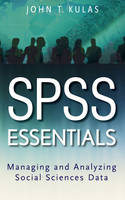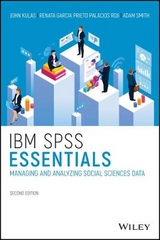
SPSS Essentials
John Wiley & Sons Ltd (Verlag)
978-0-470-22617-9 (ISBN)
- Titel erscheint in neuer Auflage
- Artikel merken
John T. Kulas, PhD, is an organizational consultant and associate professor of psychology, Saint Cloud State University, St. Cloud, Minnesota. Additionally, Kulas is consulting editor to Journal of Psychology.
Preface. The Author. PART ONE: FUNDAMENTALS OF DATA MANAGEMENT. CHAPTER ONE: INTRODUCTION TO SPSS. Chapter Learning Objectives. What SPSS Is Used For. How the Program Works. CHAPTER TWO: HOW TO ORGANIZE YOUR SPSS LIFE. Chapter Learning Objectives. The Importance of Syntax Files. Creating Your Project File Folders. CHAPTER THREE: TYPES OF DATA. Chapter Learning Objectives. Understanding Your Data. Conceptualizing Your Matrix. Data Files. Kinds of Data: An SPSS Perspective. CHAPTER FOUR: CREATING AND ACCESSING DATA FILES. Chapter Learning Objectives. Before You Open SPSS. Specifying Operations Through SPSS. Creating Data Files the Hard Way. Creating Data Files the Syntax Way. Numeric Versus String Variables. Working with Your Data Files. Importing Data from Other Programs. CHAPTER FIVE: DEFINING YOUR DATA. Chapter Learning Objectives. Notation. Defi ning Your Dataset. CHAPTER SIX: MANIPULATING YOUR DATA. Chapter Learning Objectives. Creating Scale Scores. Learning the Command Language. The Importance of Selecting All. Using the Variables Tool. Summary. Key Terms. Discussion Questions. CHAPTER SEVEN: COLLAPSING AND MERGING DATA FILES. Chapter Learning Objectives. Same People, Different Information. Different People, Same Information. CHAPTER EIGHT: DIFFERENTIAL TREATMENT OF YOUR DATA. Chapter Learning Objectives. Isolating Interesting Cases. PART TWO: SYNTHESIZING AND ANALYZING DATA. CHAPTER NINE: REQUESTING OUTPUT. Chapter Learning Objectives. The "Descriptives" Command. The "Frequencies" Command. A General Note on Analyses. A General Note About Output Files. CHAPTER TEN: INFERENTIAL ANALYSES (T-TESTS). Chapter Learning Objectives. The T-Test. CHAPTER ELEVEN: INFERENTIAL ANALYSES (ANOVAS). Chapter Learning Objectives. One-Way ANOVA ("One-Way" Command). Repeated-Measures ANOVA ("GLM" Command). Factorial ANOVA ("UNIANOVA" Command). Follow-Up Contrasts. Summary. Key Terms. Discussion Questions. CHAPTER TWELVE: INFERENTIAL ANALYSES (CORRELATION OR REGRESSION). Chapter Learning Objectives. Correlation. Simple Regression. Multiple Regression. PART THREE: ADVANCED MANIPULATIONS AND PROBLEM SOLVING. CHAPTER THIRTEEN: USING YOUR OUTPUT. Chapter Learning Objectives. Problem Solving. Maximizing Output Information. CHAPTER FOURTEEN: OTHER TRICKS OF THE TRADE. Chapter Learning Objectives. Salvaging Old Syntax. Tricking SPSS to "Think" Across Rows. "Do If " and "End If ". Summary. Key Terms. Discussion Questions. Bibliography. Other Useful References. Appendixes. Appendix A: Completed Questionnaire Form Example Appendix B: Example Code Sheet for Questionnaire. Appendix C: Summary of Creating and Defi ning a Data File. Appendix D: Example Syntax File Integrating. Multiple Commands (Fulfi lling Multiple Purposes). Appendix E: Commands to Know, Organized by Importance. Answers to Chapter Discussion Questions. Glossary. Index.
| Erscheint lt. Verlag | 19.12.2008 |
|---|---|
| Reihe/Serie | Research Methods for the Social Sciences |
| Verlagsort | Chichester |
| Sprache | englisch |
| Maße | 157 x 228 mm |
| Gewicht | 348 g |
| Themenwelt | Mathematik / Informatik ► Mathematik ► Computerprogramme / Computeralgebra |
| Sozialwissenschaften ► Soziologie ► Empirische Sozialforschung | |
| ISBN-10 | 0-470-22617-X / 047022617X |
| ISBN-13 | 978-0-470-22617-9 / 9780470226179 |
| Zustand | Neuware |
| Haben Sie eine Frage zum Produkt? |
aus dem Bereich



